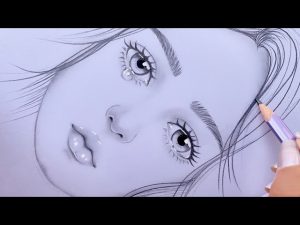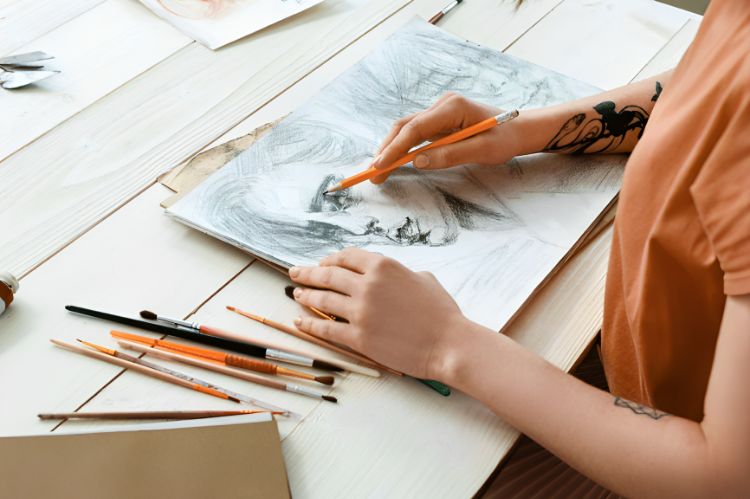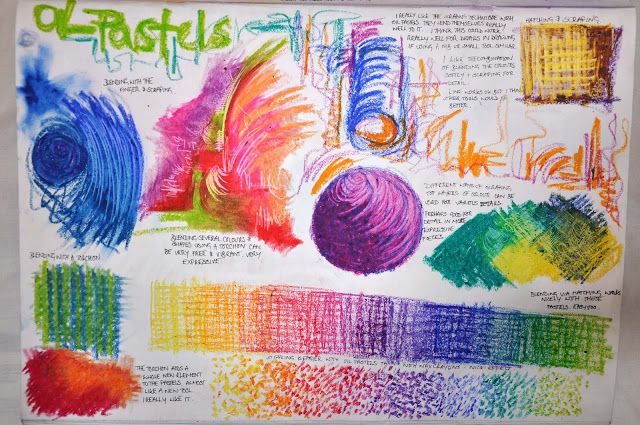Embarking on the journey of art drawing is a venture into the realm of imagination and self-expression. With the stroke of a pencil, pen, or brush, artists can bring their visions to life on a blank canvas. The act of drawing transcends mere lines and shapes; it is a language that communicates emotions, stories, and perspectives. Each stroke carries the artist’s unique signature, revealing a glimpse into their inner world. From intricate details to bold, sweeping gestures, the possibilities are limitless.

Navigating the Basics of Art Drawing
Embarking on the wondrous journey of art drawing can be both exciting and daunting. But fear not, fellow explorer! With a grasp of the fundamental principles, you’ll be well on your way to transforming blank pages into captivating creations. So, let’s delve into the essentials of art drawing:
1. Line it Up: The Power of Lines
Lines are the building blocks of Art Drawing, forming the foundation for shapes, contours, and even emotions. Experiment with different line weights, lengths, and textures to bring your drawings to life:
- Thick Lines: Bold and confident, ideal for outlining shapes and adding emphasis.
- Thin Lines: Delicate and precise, perfect for capturing details and creating intricate patterns.
- Short Lines: Energetic and playful, can convey movement or texture.
- Long Lines: Smooth and graceful, perfect for creating flowing curves and suggesting depth.
2. Shape Up: Understanding Form and Space
Shapes are the cornerstones of any Art Drawing, defining objects and providing a sense of structure. Master the art of identifying and rendering basic shapes like squares, circles, and triangles, then combine them to build more complex forms:
- Negative Space: The area around and between objects is just as important as the objects themselves. Pay attention to negative space to create balance and depth in your compositions.
- Perspective: The illusion of depth on a flat surface. Experiment with one-point, two-point, and three-point perspective to draw objects that recede into the distance.
3. Light and Shadow: The Art of Dimension
Light and shadow work together to create a sense of volume and dimension in your Art Art Drawing. Observe how light falls on objects, casting shadows that define their form and depth:
- Shading Techniques: Hatching, cross-hatching, stippling, and blending are just a few ways to create shadows and add texture to your drawings.
- Highlights: The brightest areas where light directly hits an object. Adding highlights can enhance contrast and make your drawings pop.

A Journey into Drawing
Embarking on a journey into Art Drawing is an exciting adventure! It’s like stepping into a vast, unexplored landscape, brimming with potential and beauty. Whether you’re a seasoned explorer or a wide-eyed newbie, there’s magic to be found in every stroke of your pencil. To aid you on your quest, here are some paths you can take:
1. Choosing Your Tools:
- Pencils: Your trusty companions, perfect for sketching, shading, and capturing details. Experiment with different types of pencils like graphite, charcoal, and colored pencils to discover their unique qualities.
- Paper: Your canvas, where your dreams take form. Explore different textures and weights to find the perfect surface for your artistic vision.
- Erasers: Your allies in correction, allowing you to refine your lines and embrace the freedom to experiment without fear of mistakes.
2. Charting Your Course:
- Observational Drawing: Hone your skills by studying the world around you. Nature walks, still life arrangements, and portraits offer endless inspiration. Sketch what you see, capturing the essence of light, shadow, and texture.
- Imaginative Drawing: Let your inner artist soar! Unleash your creative spirit and explore fantastical worlds, imaginary creatures, and abstract landscapes. Don’t be afraid to break the rules and paint your dreams on paper.
- Learning from Masters: Immerse yourself in the works of artists who inspire you. From classical masters to contemporary visionaries, each artist presents a unique perspective and technique to learn from.
3. Mastering the Skills:
- Linework: Learn to control your lines, varying their thickness and texture to create form, define edges, and convey emotions.
- Shading and Value: Understand how light and shadow play on objects, using techniques like hatching and cross-hatching to add depth and dimension.
- Perspective: Create the illusion of depth by understanding one-point, two-point, and three-point perspective.
- Composition: Arrange your elements on the page to create a pleasing and balanced visual experience.

Choosing the Right Tools for Your Art
Selecting the right tools for your art is an exciting part of the creative process, like picking the perfect weapon for an adventurer! It can also feel overwhelming, with so many options and diverse styles. But fear not, fellow explorer! By understanding your needs and exploring the possibilities, you’ll find the ideal partners to bring your artistic vision to life.
1. Know Thyself:
- What is your art style? Are you drawn to realism, abstraction, or something in between? Different styles often favor specific tools.
- What is your experience level? Are you a seasoned artist or just starting your journey? Some tools are more beginner-friendly than others.
- What is your budget? Tools can range from budget-friendly to professional-grade, so understanding your financial limitations is crucial.
2. Explore the Arsenal:
- Drawing: Pencils, charcoal, crayons, pastels, ink pens, markers – each offers unique textures, lines, and blending capabilities.
- Painting: Acrylics, watercolors, oils, gouache – consider drying time, opacity, vibrancy, and layering potential.
- Mixed Media: Combine different mediums like paint, ink, and collage materials for boundless creative possibilities.
- Digital Tools: Tablets and Art Drawing software open up a whole new world of possibilities, from realistic brushes to fantastical effects.
3. Matchmaker, Matchmaker:
- For Realism: Fine-tipped pencils, detailed brushes, smooth paper for precise lines and subtle blending.
- For Expressionism: Bold charcoal sticks, thick brushes, textured paper for bold strokes and vibrant colors.
- For Experimentation: Mixed media sets, water-soluble crayons, digital tools with endless brush options.
- For Beginners: Starter kits with essential tools, basic colors, and beginner-friendly materials.

Essential Tips for Aspiring Artists
The path of an aspiring artist is paved with both challenge and wonder. It’s a journey of growth, exploration, and relentless pursuit of your artistic vision. But the road can also feel daunting at times, shrouded in uncertainties and self-doubt. Fear not, fellow adventurer! Here are some essential tips to guide you as you navigate the landscape of artistic creation:
1. Embrace the Art of Practice:
- Draw every day: It doesn’t have to be a masterpiece, even a quick sketch or study will hone your skills and keep your creative juices flowing.
- Challenge yourself: Step outside your comfort zone, experiment with new techniques, and push your own boundaries.
- Learn from mistakes: Don’t see them as failures, but as stepping stones to improvement. Embrace the iterative process of learning and growth.
2. Find Your Inspiration:
- Immerse yourself in art: Visit museums, galleries, and artist studios. Explore different styles, mediums, and periods.
- Connect with other artists: Build a community, share your work, and learn from one another’s experiences.
3. Develop Your Artistic Voice:
- Explore your interests: What themes, subjects, or emotions resonate with you? Allow your unique perspective to shine through your work.
- Don’t be afraid to be different: Your individuality is your strength. Embrace what makes you stand out and don’t try to imitate others.
- Be your own harshest critic: Maintain high standards for your work, but also learn to celebrate your progress and achievements.
4. Hone Your Technical Skills:
- Master the fundamentals: Learn about composition, perspective, color theory, and Art Drawing techniques. A strong foundation will support your creative exploration.
- Take classes or workshops: Seek guidance from experienced artists and learn from their expertise.
- Practice makes perfect: Dedicate time to mastering specific techniques, from shading to anatomy to color mixing.
Exploring Digital Art Drawing Platforms
Delving into the world of digital art drawing platforms can be an exciting adventure! It opens up a vast realm of possibilities, freeing you from the limitations of traditional media and unleashing your creativity in new and vibrant ways. But with so many options available, choosing the right platform can feel like navigating a jungle. Fear not, intrepid explorer! Here’s a guide to help you discover the perfect digital art companion:
1. Choose Your Weapon:
- Desktop Software: Powerhouses like Adobe Photoshop, Corel Painter, and Clip Studio Paint offer professional-grade features, intricate brushes, and advanced customization. Be prepared for a steeper learning curve and potential subscription fees.
- Mobile Apps: Procreate and Adobe Fresco offer portability and convenience, with intuitive interfaces and touch-optimized tools. Perfect for on-the-go sketching and creating smaller pieces.
- Web-Based Platforms: Tools like Krita and Pixilart are browser-based, requiring no downloads or installations. Great for casual exploration and collaboration, but may have limitations in features and performance.
2. Consider Your Needs:
- Budget: Free options like Krita and GIMP exist, while premium software like Clip Studio Paint offer one-time purchases or subscriptions. Consider your budget and commitment level.
- Skill Level: If you’re just starting, user-friendly interfaces and intuitive apps like Procreate might be a good fit. Experienced artists may prefer the advanced features of desktop software.
- Specific Features: Do you need specific brush libraries, animation tools, or 3D sculpting capabilities? Research different platforms to find one that caters to your artistic desires.
3. Explore the Landscape:
- Watch tutorials and reviews: Learn about the pros and cons of different platforms and get a feel for their interfaces and workflows.
- Try free trials or demos: Many platforms offer trial periods or limited-feature demos, allowing you to test them out before committing.
- Join online communities: Connect with other digital artists, ask for recommendations, and learn from their experiences.
Drawing from Life and Imagination
Drawing from life and imagination are two distinct, yet complementary, approaches to art-making, each offering unique benefits and challenges. Choosing between them, or even combining them, can be a personal choice based on your artistic goals and preferences.
Drawing from Life:
- Sharpening Your Observational Skills: By directly observing objects, people, or scenes, you hone your ability to capture precise details, proportions, and relationships between elements. This translates to stronger fundamentals and accuracy in your artwork.
- Understanding Light and Shadow: Art Drawing from life allows you to study how light interacts with real-world objects, creating realistic shadows, highlights, and reflections that add depth and dimension to your drawings.
- Embracing Imperfection: Real-life subjects are rarely perfect, with their quirks and irregularities. Drawing from life encourages you to appreciate these imperfections and incorporate them into your artwork, adding character and realism.
Drawing from Imagination:
- Unlocking Boundless Creativity: Your imagination is limitless, allowing you to create fantastical worlds, invent creatures, and depict impossible scenarios.
- Expressing Emotions and Ideas: Imaginative drawings can be powerful tools for expressing personal emotions, exploring concepts, and conveying abstract ideas.
- Developing Artistic Style: Experimenting with your imagination fosters artistic freedom and helps you discover your unique artistic voice and style.
- Flexibility and Freedom: You’re not constrained by external factors like lighting or pose, allowing for quick composition changes and dynamic poses.
- Challenges: Maintaining internal consistency, avoiding clichés, and effectively communicating your vision through purely imagined visuals can be challenging.
Combining Both Approaches:
Many artists blend these two approaches to create even richer and more engaging artwork. You can use observational drawing studies as the foundation for imaginary creatures, combine real-life elements with fantastical scenarios, or use life drawing exercises to spark creative ideas for future imaginative pieces.
Pushing the Limits of Traditional Drawing
Pushing the limits of traditional drawing is an exhilarating journey, where you break free from conventional techniques and unleash your artistic spirit to explore uncharted territories. It’s about experimentation, innovation, and defying expectations, leaving behind predictable lines and venturing into the realm of bold expression. Here are some ways to push the boundaries of your traditional drawing practice:
1. Unconventional Tools and Materials:
- Embrace the unexpected: Ditch the pencil and explore drawing with ink washes, charcoal dust, coffee grounds, or even feathers. Experiment with textured papers, found objects, and unconventional surfaces like wood or metal.
- Challenge yourself with scale: Go miniature with insect-sized drawings or create sprawling epics across multiple canvases.
2. Reimagine Form and Perspective:
- Distort and fragment: Embrace cubism, abstraction, and surrealism to break down traditional forms and rebuild them in new and unexpected ways. Experiment with multiple perspectives and unconventional viewpoints.
- Play with negative space: Don’t just focus on the subject, consider the empty space around it as an active element, using it to create tension, balance, and depth.
3. Inject Unexpected Techniques:
- Incorporate collage: Cut up old drawings, photographs, or fabrics to create layered textures and add new narratives to your work.
- Blend traditional with digital: Scan your drawings and manipulate them digitally, adding effects, textures, or combining them with other images.
4. Explore Light and Shadow in New Ways:
- Go beyond realism: Experiment with bold, non-representational shapes for shadows, or use light to create dreamlike auras or distorted reflections.
- Play with unconventional light sources: Don’t be limited to the sun, consider firelight, neon reflections, or even imaginary sources to create dramatic and unexpected effects.
Frequently Asked Questions (FAQs)
Practice regularly, study anatomy, observe real-life subjects, and seek feedback from other artists. Online tutorials and classes can also be valuable.
Start with quality pencils, sketchbooks, erasers, and a sharpener. As you progress, you may explore different mediums like colored pencils, markers, or digital tools.
Experiment with different techniques, subjects, and mediums. Your style will emerge over time as you incorporate elements that resonate with you personally.
Related posts:
- Cute Easy Drawings
- Oil Pastel Drawing : Mastering the Art of Oil Pastel
- Santa Claus Drawing : Tips for Drawing
- Save Water Drawing : How Art Inspires a Water-Wise Future
- Simple Drawings : Finding Beauty in Basic Lines
- Tree Drawing : A Beginner’s Guide to Drawing Trees
- Christmas Tree Drawing
- Drawing Colour




















